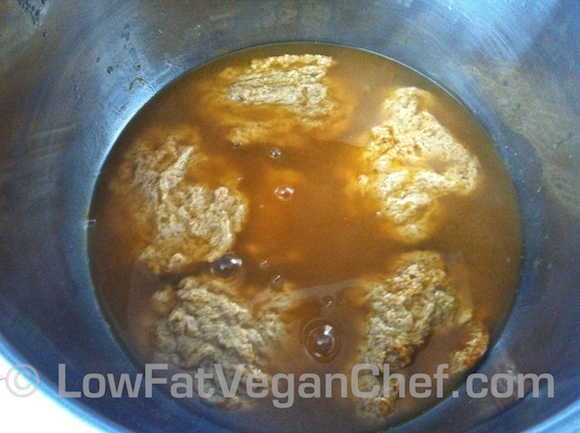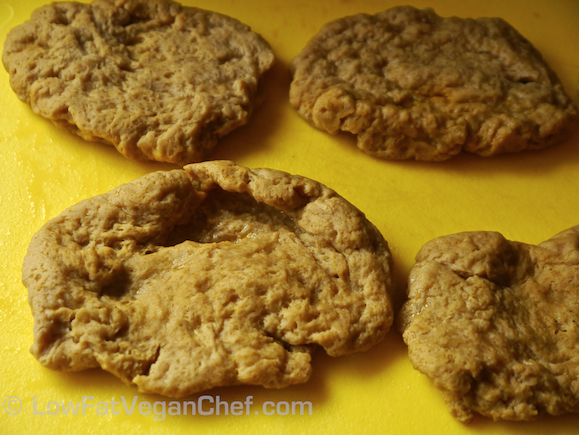Seitan or “wheat meat” is made from wheat gluten, the protein that makes wheat flour stick together and makes bread spongey. Seitan is often used to make mock meats and is frequently used in vegetarian Chinese cuisine. It’s also used in Tofurkey products along with tofu to help it stick together.
I was a little apprehensive about making my own seiten as I had never made it before, but it turns out to be VERY easy. To make seitan quickly it is faster to just buy vital wheat gluten “flour” (which is essentially just wheat protein with all of the starch removed). You can still make seitan using regular flour, but you have to soak it overnight and wash away all the starch and you don’t end up with as much gluten left compared to the flour you started with.
And just a note if you have celiac disease or gluten intolerance, please don’t make this recipe! I don’t have any problem consuming wheat or gluten containing products, so I use them occasionally as part of a low fat plant based diet.
Let’s get started.
How To Make Seitan From Vital Wheat Gluten
Makes 4-6 seitan cutlets
Ingredients:
1 cup vital wheat gluten (I used Bob’s Red Mill)
1 tsp garlic powder
1 tsp ginger powder
3/4 cup vegetable broth (low sodium) or water
1-2 tbsp light soy sauce or tamari
6 cups vegetable broth (for cooking)
Directions:
1. In a medium to large sized bowl, combine vital wheat gluten and dry spices.
2. In another bowl, mix the soy sauce and 3/4 cup of vegetable broth or water.
3. Combine the wet ingredients with the dry ingredients and stir together. It should become very sticky. Use your hands to form it into a ball.
4. Knead the seitan a dozen times to ensure it’s spongey and allow it to rest for 5 minutes.
5. Separate the ball of seitan into four or five smaller chunks. Stretch each piece of seitan into a thin cutlet as best you can to around 3/4″.
6. Add seitan to 6 cups of vegetable broth in a large pot and bring to a low boil and then reduce to a simmer for 1 hour. Depending what you are using the seitan for you can add additional seasonings or vegetables for flavor as well. Make sure you have enough liquid to cover the seitan. It will expand a lot while cooking and puff up.
7. Drain seitan and chop up to use in a recipe, or dry it off and store in a ziplock bag or a tupperware container in the freezer. You can double the recipe and make two batches to make this more cost effective if using vegetable broth.
Check out my Seitan Makhani (“Unbuttered Chicken”) recipe here.
What do you think? How did you seitan turn out?





